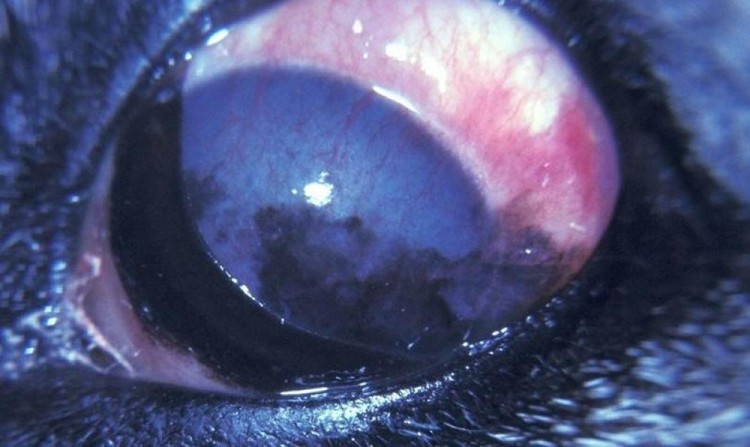What to Know About Chronic Superficial Keratitis (Pannus) in Dogs
Though not life-threatening, corneal inflammation can cause significant discomfort. Learn more about symptoms and treatment options in this article.

The surface of the eye, or cornea, is designed to be transparent so that light passes straight through to the light-sensitive retina.
The cornea is made of strong yet clear tissue, but its ability to remain transparent is impaired when damaged. As it tries to heal an injury or inflammation, blood vessels invade the cornea to deposit healing cells, causing it to become cloudy.
If the eye remains inflamed for several weeks, the cornea tries to protect itself from further injury by flooding the area with pigment. This brown pigment is permanent, the cornea is no longer transparent and the dog’s vision is affected (like wearing dirty spectacles).
Problems such as lashes rubbing the eye, in-turned eyelids or lack of tear fluid can cause significant trauma to the surface of the cornea, which then leads to inflammation, or keratitis. This is known as pannus.

Don’t leave your pet’s safety to chance
Sign up for Petful recall alerts today.

Symptoms
Non-ulcerative keratitis is a game of consequences. First, the surface of the eye becomes irritated. This then causes inflammation, which then makes the eye misty. If this goes on for long enough, the mistiness changes to brown pigment.
Thus, the signs depend on how long the problem goes on.
As time progresses, you might notice:
- Angry blood vessels appearing on the surface of the eye
- The surface of the eye looks misty
- The eye looks sore and inflamed
- A thick mucus discharge from the eye
- The mistiness becomes more obvious
- Patches of brown pigment appearing on the cornea

Causes
Anything that irritates the surface of the eye can cause keratitis, such as:
- Inadequate tear production (the surface dries out)
- Eyelashes rub the cornea (mechanical irritation)
- Blunt trauma to the eye
- Infections
- Immune-mediated disease (the body attacks its own eye tissue)
- Bulbous eyes (the lids don’t close fully when the dog is asleep)
- A result of a problem inside the eye such as glaucoma or anterior uveitis
Diagnosis
Key to treating keratitis is not just reaching a diagnosis, but looking deeper to find the reason it happened in the first place.
To do this, a veterinarian examines the eye with an ophthalmoscope, using magnification to check for stray eyelashes rubbing against the surface.
In addition, she measures the amount of tear fluid produced (a Schirmer tear test) and will pop a special dye into the eye to rule out the presence of ulcers. The latter is important because an ulcer rules out the use of a topical steroid, which is one of the treatments for keratitis.
Treatment
The underlying reason for the inflammation must be corrected via surgically removing ingrown eyelashes or treating eye infections with antibiotics. If the keratitis hasn’t then settled down, topical steroid ointments will decrease the inflammation.
In some cases, such as the condition dry eye, where the eye doesn’t produce enough natural lubrication, the dog may require therapy with false tears.
Another treatment for this is cyclosporine, a drug developed to prevent organ rejection in transplant patients. It switches off the body’s immune response, preventing it from attacking the tear fluid glands. Putting cyclosporine into the eye twice a day is the gold standard treatment, but it is an expensive medication and a big financial commitment in the long term.
No eye drop will shift the thick brown pigment once it is deposited; it can, however, be surgically removed by a specialist in a procedure called a keratotomy, where the top layers of the cornea are carefully shaved away.
Prevention
Some cases of keratitis are made worse by UV light. Keep your dog indoors in bright sunlight or fit him with doggy sunglasses!
Keratitis caused by lack of tear production requires lifelong medication — a case of control rather than cure, but with effort and commitment, you can protect your dog’s vision.
Reference
- Small Animal Ophthalmology. Pfeiffer & Peterson-Jones. Publisher: WB Saunders. 3rd edition.
This pet health content was written by a veterinarian, Dr. Pippa Elliott, BVMS, MRCVS. It was last reviewed Oct. 13, 2018.







